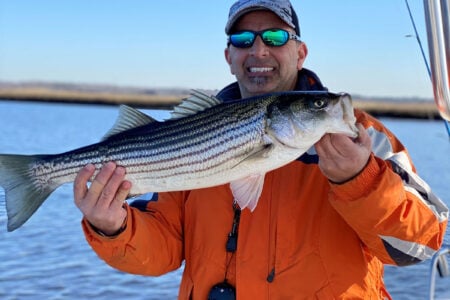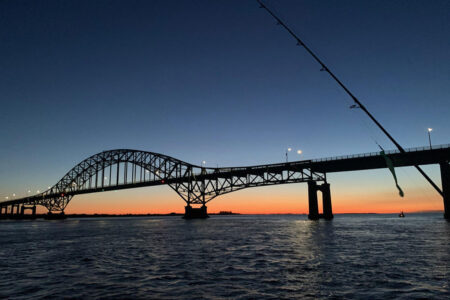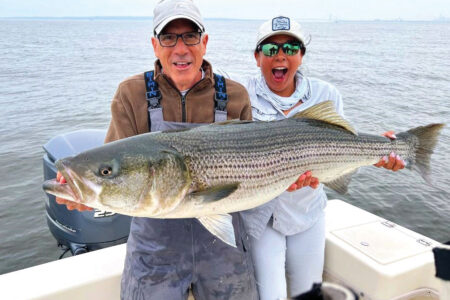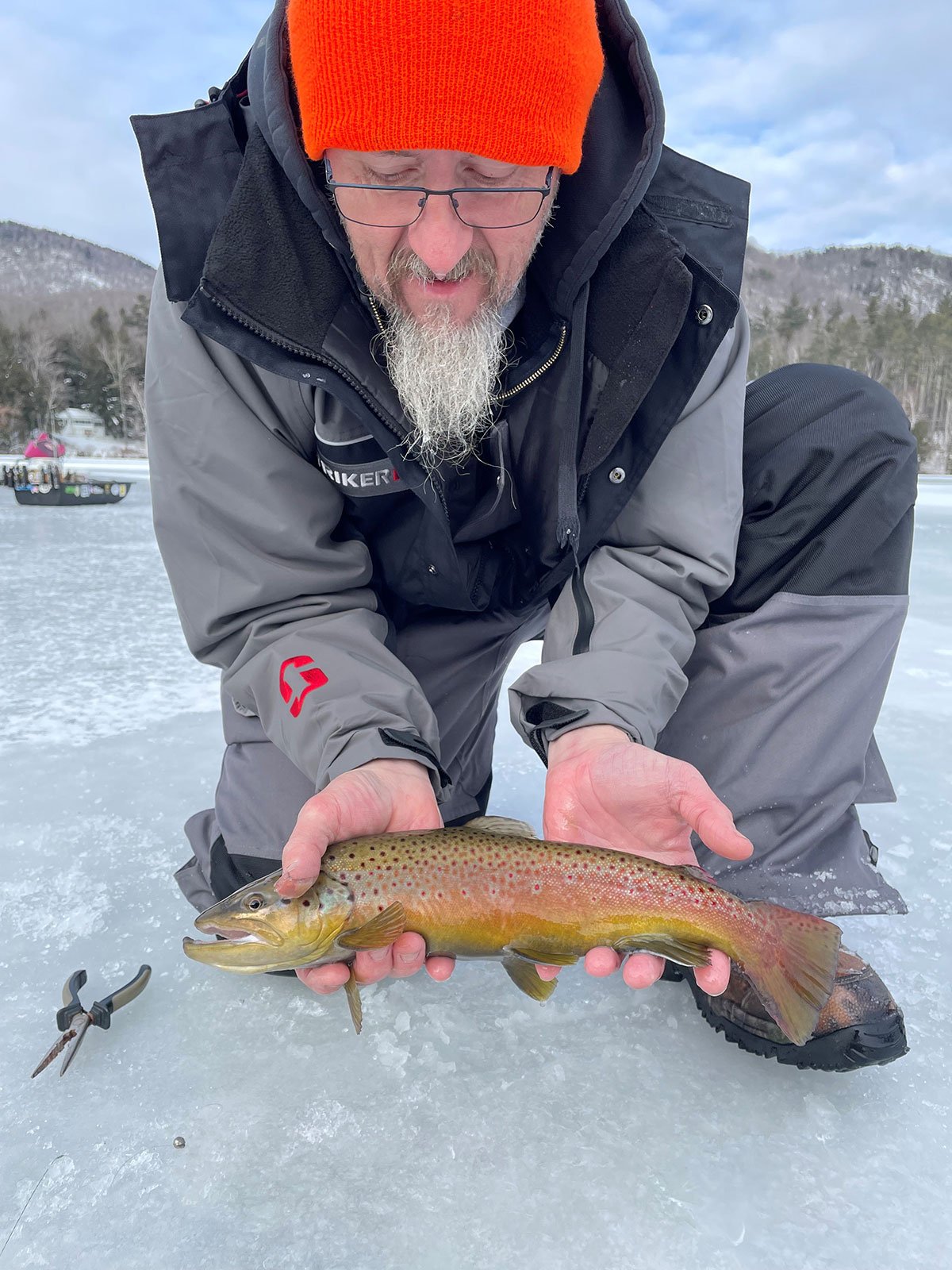
Striper fishermen can use their knowledge to find winter success on the ice!
Striped bass fishermen are often obsessive and the wintertime can be tough for us. After the hustle of the holidays passes and we cross over into a new year, all the trials and tribulations, all the excitement and lost sleep is over. While some may run south to get one more shot and others might look for a spot where holdover stripers may be caught, most of us are washing rods, cleaning and greasing reels, changing out rusty hooks and bathing lures to get every last bit of salt off. For me, the toughest part of this time of year is putting everything in storage until spring.
The thought of not fishing for months drives some of us crazy and the need for some kind of tug at the end of the line or something to help keep our skills sharp, increases with each frigid day. Being striped bass fishermen, we can utilize our skills for other types of fishing. We may not need to cast as far or use heavy gear and big baits, but with the knowledge of how an ambush predator stalks its prey and how they use structure and contour to ambush them, we can apply that knowledge and find success.
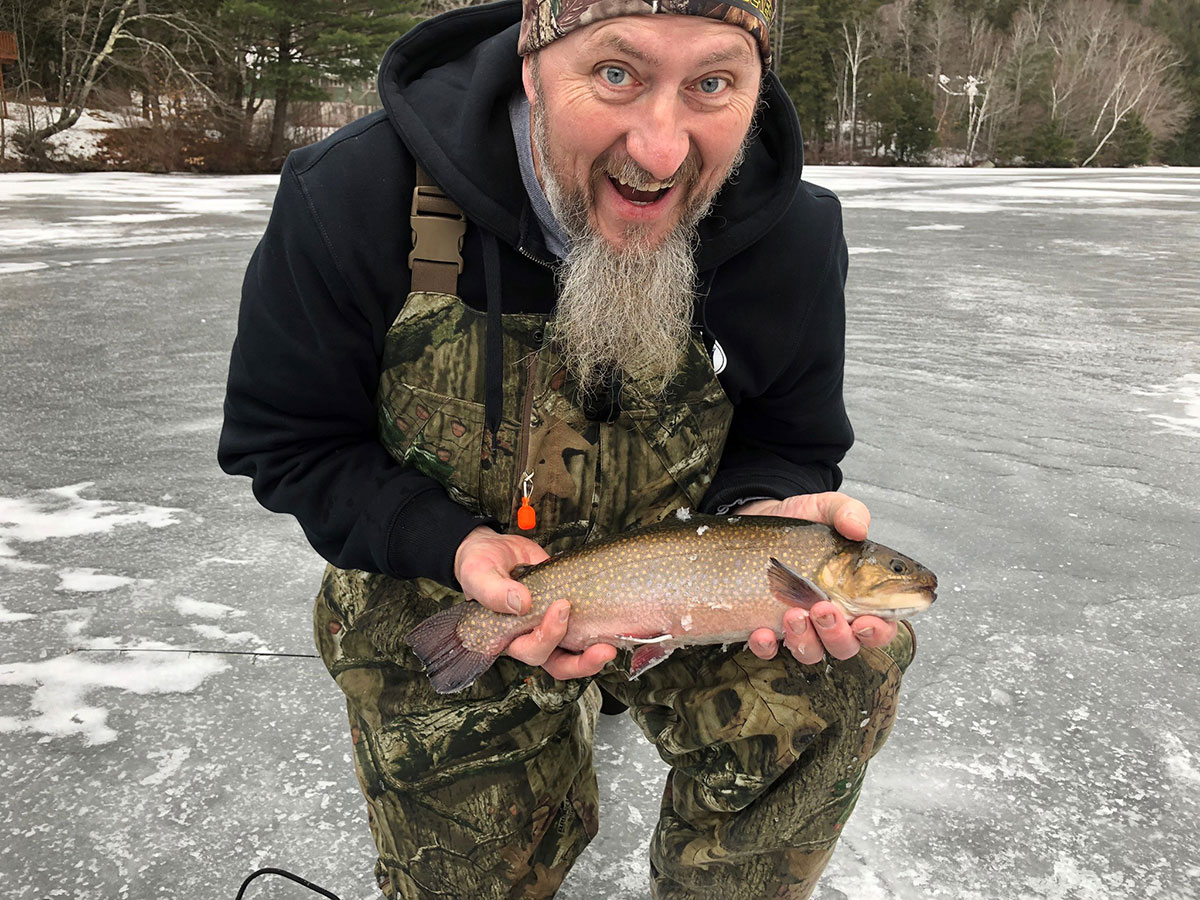
Iced Up
One of the things I do to help pass the time between the fall and spring striper migrations, is hit the frozen ponds for some hardwater fishing. In spite of what you might see on YouTube, it doesn’t take much, they often make it seem like you need all kinds of gear and expensive fish finding electronics. However, most of the gear I have is relatively inexpensive and easy to find. If you ask me, the hardest thing is to get a hole in the ice! I have a hand auger that I found at a yard sale and replaced the blades. (You can also get an ice fishing chisel or what’s called a spud bar to knock holes in the ice.) My jigging rods and reels are the cheap ones you’ll find at most tackle shops that cater to ice fishing and they do the job just fine. When I decided to buy tip-ups (ice fishing traps) I just bought what was on sale and they have not done me wrong. A stop at your local tackle shop will fill your needs as far as jigs, line, hooks and some shiners or worms, and you’ll be drilling holes in the ice without burning a hole in the wallet.
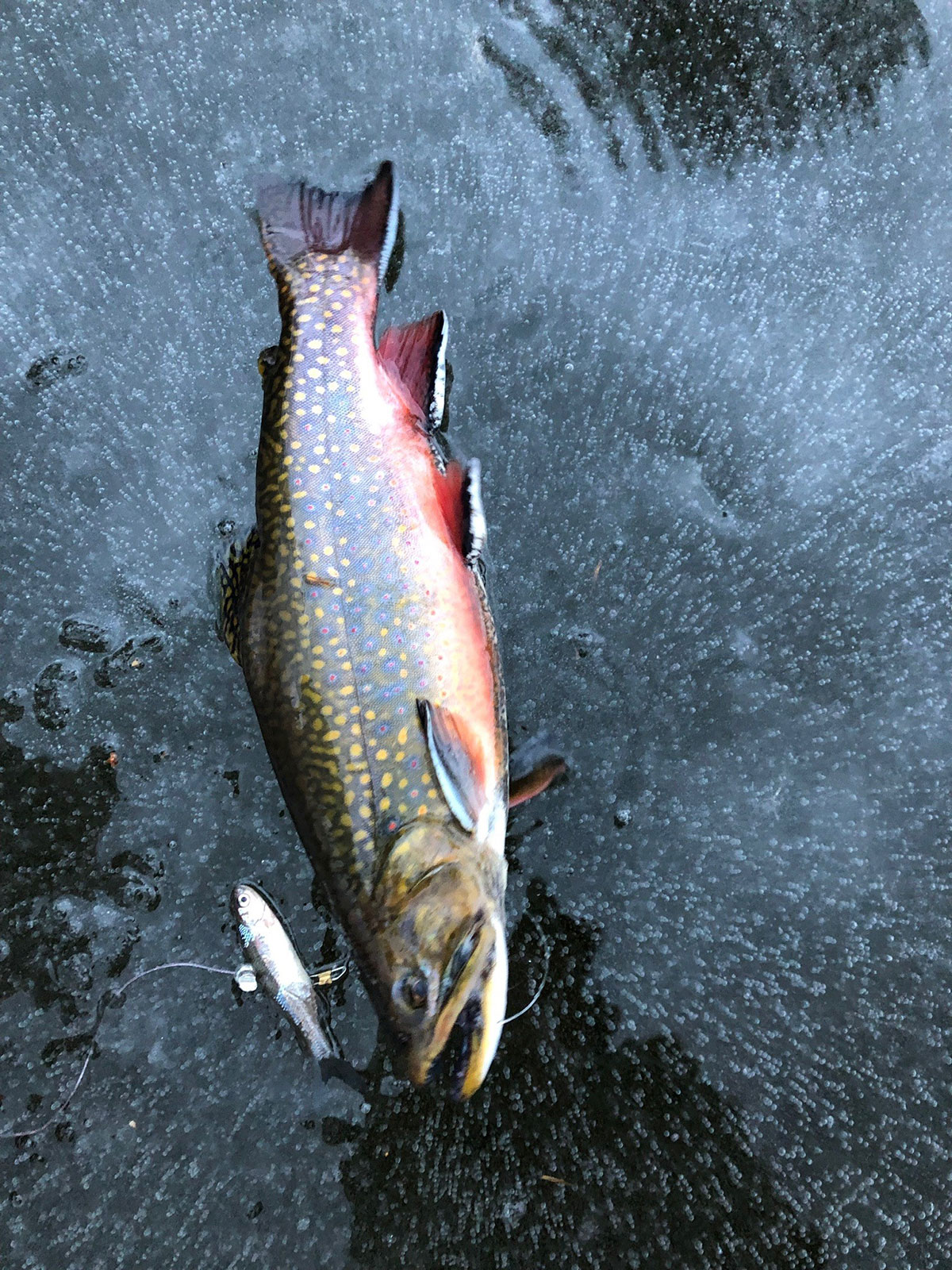
Keeping It Simple
I have not found that jig color or style is terribly important when fishing through the ice, if it’s designed to be fished through the ice, it will work. Keep your jig box simple with a few styles and colors, the only thing that I have found to be very important is keeping things small; you can catch giant largemouth and small perch on the same jig. With all that said, it’s still wise to ask the staff what’s been working locally and where the best bite has been.
I have found my best success using pink, white and chartreuse jigs. I’ll use round and teardrop jigheads in weights ranging from 1/16 to 1/8 of an ounce. I tip them with mini soft plastic such as Clams Maki plastics. Also don’t overlook Kastmasters and Swedish Pimples they are inexpensive, available just about every bait shop and carry a long history of ice fishing success. As long as it is shiny, bright or wiggly, fish will find it. If you find hungry fish they will generally eat whatever you put through the ice.
I keep the terminal tackle simple and ‘low budget’ as well. Some of those high tech ice fishing lines can get pretty pricey, but I save the braid from my freshwater reels or even surf rods and use it on my ice fishing spools. I’ll tie in a 4- to 8-pound monofilament leader and tie direct to my jigs or hooks, no need for clips or swivels.
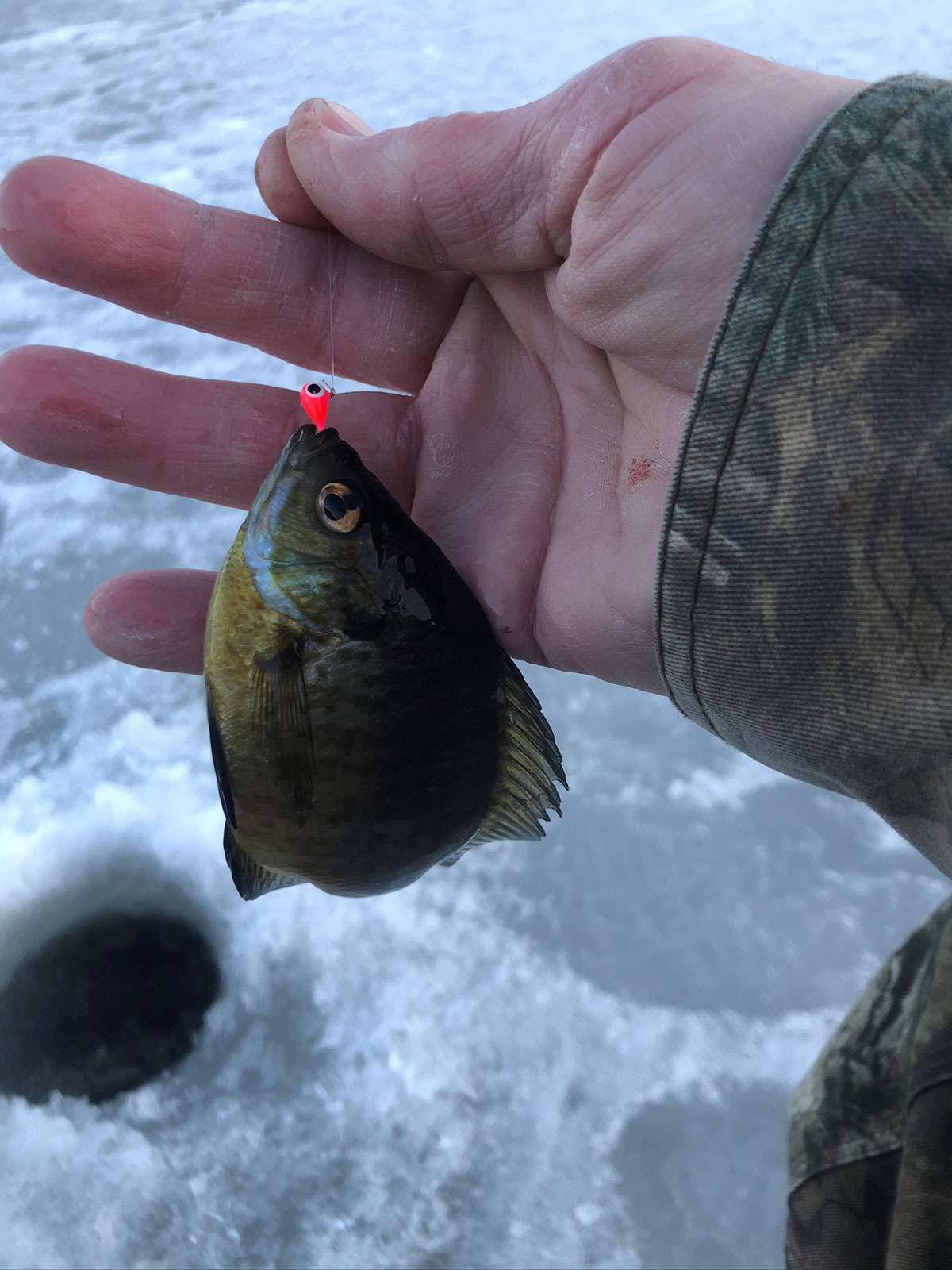
Use Your Head
At the beginning of ice fishing season (and during these warmer winters) it can be difficult trying to find safe ice, but that hasn’t stopped some of us from getting out. If you can plan for a little extra time and drive north a bit, you’ll likely find ponds and lakes with anglers and skaters already on them. While this is a good place to start, you should always check the ice for yourself before setting up.
When fishing a new pond, if you don’t have electronics, you may think it would be impossible to find spots to fish. But don’t forget your roots. As fishermen, we spend our lives looking at the water, maps and satellite images in search of new and productive fishing spots. Since I am surfcaster, I don’t ever have the luxury of using electronics to tell me what I’m fishing, but even with ice covering the lake, there are still clues we can use to find a great spot.
For example, if you pull up to a new spot and you look at the ice how do you tell what’s underneath? When you think about what’s on the shore you can relate that to what’s under the ice, a point of land will typically continue out under the ice. A small cove may have a little deeper area towards the middle. A fallen tree may continue well below the ice creating structure. Also the makeup of the shoreline may tell you things about what’s under the ice, if the shoreline is rocky, the bottom is likely to be rocky too, if there’s an area where a gravel shoreline transitions to mud or sand, that may continue underneath as well.
With that said, using your intuition and reading the shoreline means you can always pick out a spot that seems fishy. Choose a spot where you would like to start and make a hole or two and check the depth simply by putting a weight at the end of your line and dropping it down. Then move 10 feet or so, check again and keep repeating, when you find a significant difference that will be a good place to start. While checking your depth it’s a good idea to let your weight hit the bottom and you’ll be able to feel whether it’s hard or soft bottom. A hard clunk means it’s rocky, a solid thud means packed sand or clay, a gentle landing or finding the weight stuck, means soft or muddy bottom. Also look for vegetation on your weight, green weeds will tell you there’s more oxygen and possibly a lot more life than brown weeds.
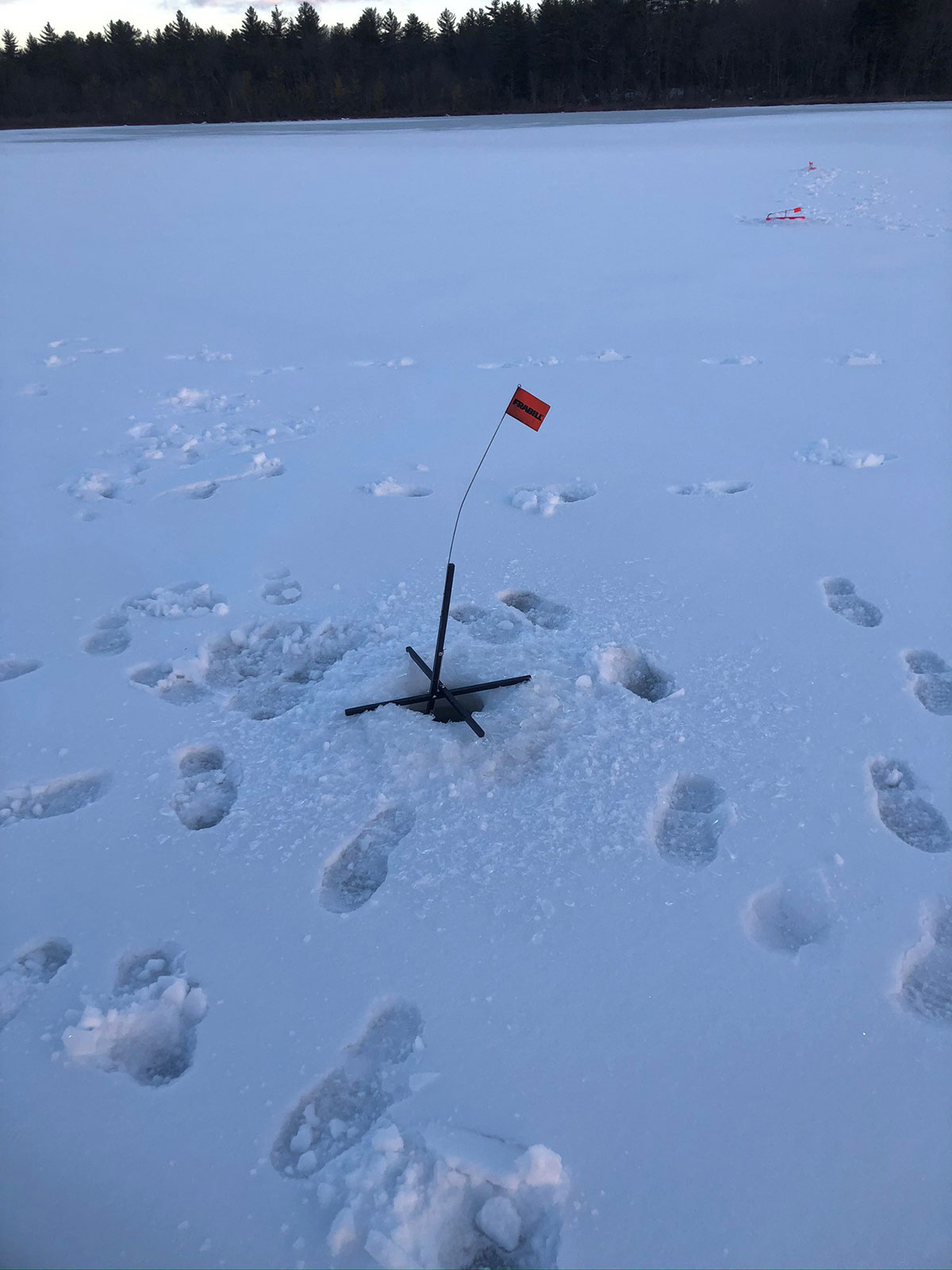
Lines Of Attack
Once you settle on a starting point, you can always adjust your lure and presentation to target the fish for that depth. If you decide to jig there are several ways to entice a strike. Start by dropping the jig to the bottom and then crank it up a turn or two. Then begin making short slow lifts and drops of the bait. If that’s not doing the job you can vary how fast you lift and lengthen or shorten how far you lift the jig. Sometimes even just a little jiggle will get something to bite.
| SAFETY ON THE ICE |
| Even if you see others on the ice you should check it for yourself. Carry a spud bar to quickly knock a hole in the ice to check thickness. As you make your way onto the ice, check the thickness every 20 feet until you’re confident that it’s safe. Four inches of ice is safe to walk on and anything less is not worth taking the chance. And don’t be fooled by small ponds, just because they’re small, does not guarantee thicker ice, many shallow ponds contain decaying plants and this decomposition process can generate enough heat to create soft spots. Keep checking as you go, falling through is just not an option! |
Or if you want to take a more relaxing approach, set out a few tip-ups. It’s as simple as checking your depth and dropping down a worm or a shiner keeping it off the bottom a few inches and you can let it sit while you drill a few more holes. Sometimes it pays to set them up so you’re covering a span of depths, the first closer to the shore, the last one closest to the middle of the pond. Other times you may want to try and shadow a contour line or weed line. Tip-ups account for some truly impressive fish every year.
When fishing new water the most important thing (which is similar to surfcasting) is to never stand still for too long, work a couple different depths along with in tight to shore and away from shore. With a little work you could possibly get into multiple species in one outing. And once in a while you get lucky and hook into a special fish and it makes for a great day on the ice. While ice fishing could never equal surfcasting for me, it sure makes waiting for the stripers to return more fun and less painful.
